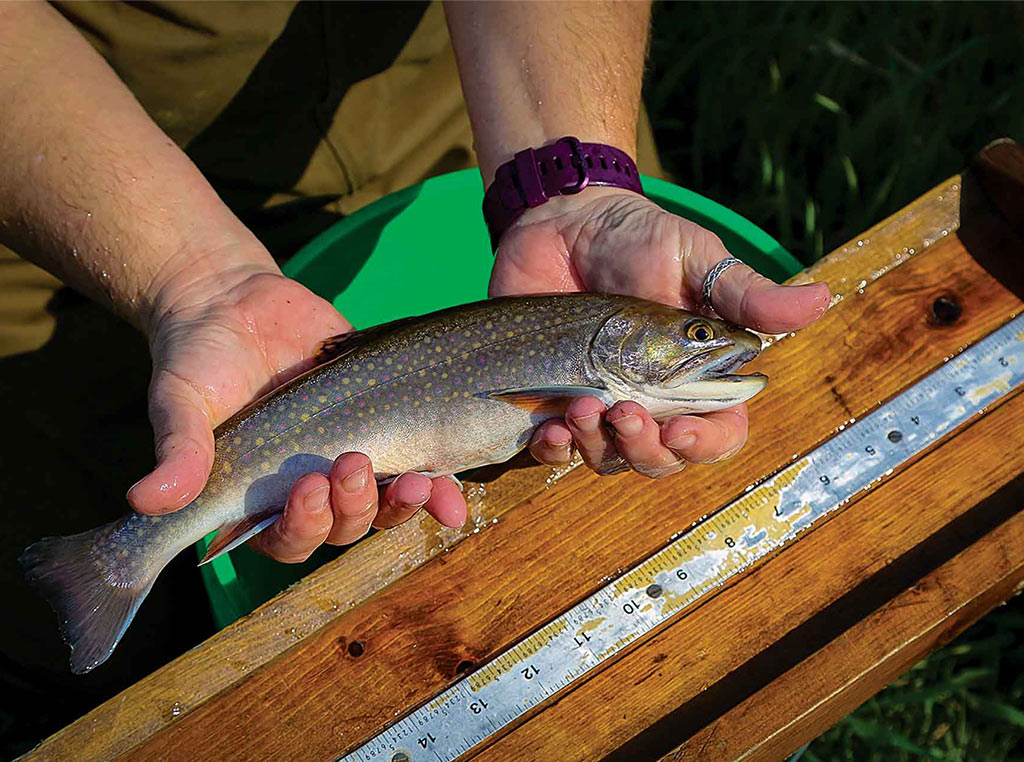Agriculture, Sustainability September 01, 2022
Corn, Cows…and Trout
.
Commercial agriculture and conservation team up to boost Iowa brook trout.
It is a sparkling crisp afternoon in northeast Iowa, and the fishing is good. The electrofishing, that is, as Theresa Shay delivers a minuscule jolt from her backpack shocker to temporarily stun brook trout hiding in a tiny sliver of a stream near Cresco called Silver Creek.
Hunter Slifka follows close behind, netting one little brookie, then another—eventually landing a healthy mix of ages and sizes of a genetic strain of brook trout that is native to the region, its ancestors swimming in these same waters long before Europeans settled here.
Shay measures an individual from the catch, and takes a moment to admire its magnificent multicolored dot pattern before returning it to the stream. "These are cool fish," she says.
Above. Addressing concerns over bacterial contamination in Silver Creek, farmers have adopted practices such as concrete manure storage pits and deep-pack bedded barns. An arched rock rapids mitigates a historic dam to allow trout to move upstream.
Team effort. Conservation is cool as well in Howard County, Iowa—thanks to a cascade of cooperation between landowners, family farmers, and various state and federal agencies—and the resurgence of brook trout is evidence that the team effort is paying off.
The folks wading in the stream represent two key players; Shay is with Iowa’s Department of Natural Resources, and Slifka serves as the watershed project coordinator for the Turkey River headwaters and Chihak Creek water quality project for the Howard County Soil and Water Conservation District.
Trout restoration has quietly built up a record of success in Iowa. In the 1980s, only a half-dozen Iowa streams supported naturally reproducing trout; by 2021, more than 80 streams supported spawning, with 50 of those streams considered self-sustaining, not requiring any additional stocking to maintain the population.
Most of those streams support brown trout; brook trout are an even more challenging species, requiring the coldest and cleanest water to thrive. In Howard County, the Turkey River project and the Silver Creek water quality project provide practices that allow modern agriculture to coexist with cold-water trout havens.
Ironically, trout restoration wasn't a part of the planning for the Silver Creek project back in 2012, when the groundwork was being laid for this water-quality effort. "The main resource concern was bacterial contamination," recalls Neil Shaffer, who serves as the Silver Creek watershed project coordinator. "Silver Creek was on the Iowa DNR 303(D) impaired water list due to bacterial contamination that was running 5.5 times the state criterion." That was particularly troubling because Silver Creek is a tributary of the Upper Iowa River, which is recognized as one of the nation's top 100 canoing destinations.
The 22,410-acre Silver Creek watershed, stretching across Howard County and into neighboring Winneshiek County, is home to a diverse mix of agricultural enterprises. Corn and soybean crops are joined by small grains and alfalfa, mid-sized commercial dairy farms and beef cattle operations.
Shaffer went to work, one farm at a time, helping farmers and landowners adopt conservation practices ranging from nutrient management plans to grassed waterways and filter strips along streams. Dairy operations took advantage of opportunities to build manure storage pits and bring dry cows and heifers out of open lots and into deep-pack bedded barns.
Primary funding for the Silver Creek project is provided by EPA Section 319 funds awarded by Iowa DNR, along with watershed protection funds administered by the Iowa Department of Agriculture and Land Stewardship. "We have four things in mind when we bring conservation practices to these upland areas," Shaffer says. "We want to reduce soil loss; we want to improve water quality; we want to enhance wildlife habitat; and we want to increase net farm income. Sometimes it is the fourth one that is the most important in convincing people to put conservation on the land."
He points out that precision conservation is helping to get more farmers involved in the project. "They come in with a yield monitor map, and they show me where their yields are suffering and their returns are the lowest," Shaffer says. "We try to find ways to put conservation measures on those particular acres that can improve environmental stewardship of the land while adding to the farm's bottom line."
Above. Hunter Slifka has seen cover crop plantings quadruple in the Turkey River watershed. Mike Steuck says practices that control erosion are critical for trout habitat. Brandon Reis believes brook trout provide a barometer of environmental stewardship. Neil Shaffer reports more than $8 million has been invested in conservation practices in Silver Creek watershed since 2012.
Momentum. That approach has been successful; more than 160 cooperators have installed more than $8 million in conservation practices in the Silver Creek watershed over the past decade. More than 30 miles of grassed waterways have been constructed since 2012; nearly two dozen septic systems have been upgraded as well as a part of the project, helping eliminate another source of bacterial contamination. Team efforts also helped mitigate a dam on the historic Vernon Mill Pond, replacing it with an arched rock rapids that allows trout and other species to migrate upstream to the small slivers of water where they can find favorable habitat.
Cover crops are another practice that helps protect streams; Hunter Slifka points out that, in his Turkey River project, cover crop acres have quadrupled in just the past couple of years.
Those cover crops help hold soil in place. That's critical for improving water quality for trout. "Sediment is key," says Mike Steuck, a fisheries specialist with Iowa DNR. "Trout lay their eggs in a nest. Sediment delivery to that water can suffocate the eggs."
Brandon Reis farms the land surrounding the stream where Slifka and Shay were sampling the brook trout. He has installed filter strips and pollinator habitat, and uses no-till and cover crops; his efforts, along with fellow Howard County farmers, have allowed stream quality to improve to the point that DNR has stocked the streams with native South Pine brook trout.
"The brook trout are a connection to the history of this area," Reis points out. "They are a barometer of our stewardship. If we are being good stewards of the land, it will be reflected in the health of the stream." ‡
Above. Stream sampling shows that brook trout are thriving in streams protected by conservation practices. Brilliantly colored South Pine brook trout are native to northeast Iowa. Dry cows and heifers enjoy comfort in a deep-pack bedded barn.
Read More

AGRICULTURE
John Deere Showcases Agricultural Innovation in America's Front Yard

AGRICULTURE, SPECIALTY/NICHE
From Shop to Shore
Food trail links farms and food along Oregon's coast.










